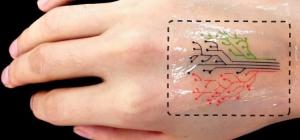Not only helping to beautify, this tattoo also has many useful uses such as: detecting pollutants in the environment or changes in body temperature, pH.
The tattoo is divided into sections containing live bacteria , which fluoresce when exposed to special compounds. When the patch on the skin comes into contact with these substances, the bacteria recognize the chemical that causes the branches on the tattoo to light up.
The research and improvement of stimulus-sensitive materials to turn them into smart materials has been going on for decades. For example, a material that reacts to heat could be used to create a self-assembled robot or a moving robot. And a material that can react to chemicals is used as a chemical sensor.
We all know that 3D printing is an easy way to create adjustable objects at a low cost. Therefore, it is extremely popular with scientists when they want to create experimental objects in laboratory settings – including creating materials that are sensitive to stimulation.
A team of engineers, led by Professor Xuanhe Zhao of the Massachusetts Institute of Technology MIT, have realized that they can use living cells in 3D printed materials.

Create a “live” tattoo. (Photo: Advanced Materials).
Previous studies in this area have shown that mammalian cells will not be able to function in the way that scientists at MIT expected. They cannot survive the harsh conditions of 3D printing, such as pressure during object ejection or UV exposure during cross-linking – this is the usual method. to create 3D printed materials.
Mr. Hyunwoo Yuk – co-author of the study, said: “During the experiment, we found that these cells die gradually during the printing process. Because of mammalian cells mostly made up of bubbles with a simple lipid bilayer. They are too weak and easily broken.”
On the other hand, bacterial cells also have protective cell walls, making them more difficult to use in making materials. However, these cells are compatible with most hydrogels – materials made of water and polymers used for a variety of laboratory and medical applications.
Based on that, the team found a way to use genetically programmed bacterial cells that fluoresce in response to chemicals. Scientists have developed an ink made of hydrogel, cells, and a mixture of nutrients to keep cells alive.
These inks give very good results, they can be used to print objects with resolutions as high as 30 micrometres. The team printed the prototype onto an elastomer, then glued it to the skin. After a few hours, parts of the plant model lit up as the bacteria in turn were exposed to chemical stimuli.
The researchers have also engineered bacterial cells that are able to “communicate” with each other and fluoresce when they receive a certain signal from another cell. They tested this 3D structure by combining the hydrogel fiber with a 3D printed double-layer glass coating. Tattoos only glow where they come into contact with cells and when they receive a “contact” signal.
“This is a very promising project in the future, we hope to be able to print ‘living’ computing platforms that we can carry around,” said researcher Yuk. In the short term, the team is looking to manufacture chemical sensors as well as drug delivery systems programmed to deliver drugs or glucose into the body.
“Live” tattoos have many applications and can be used to detect environmental contaminants or changes in body temperature or pH.
The research was funded by the Office of Naval Research, the National Science Foundation, the National Institutes of Health, and the military’s Institute of Nanotechnology at MIT. The study was published in the journal Advanced Materials.

